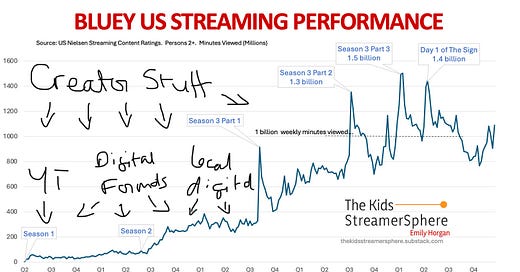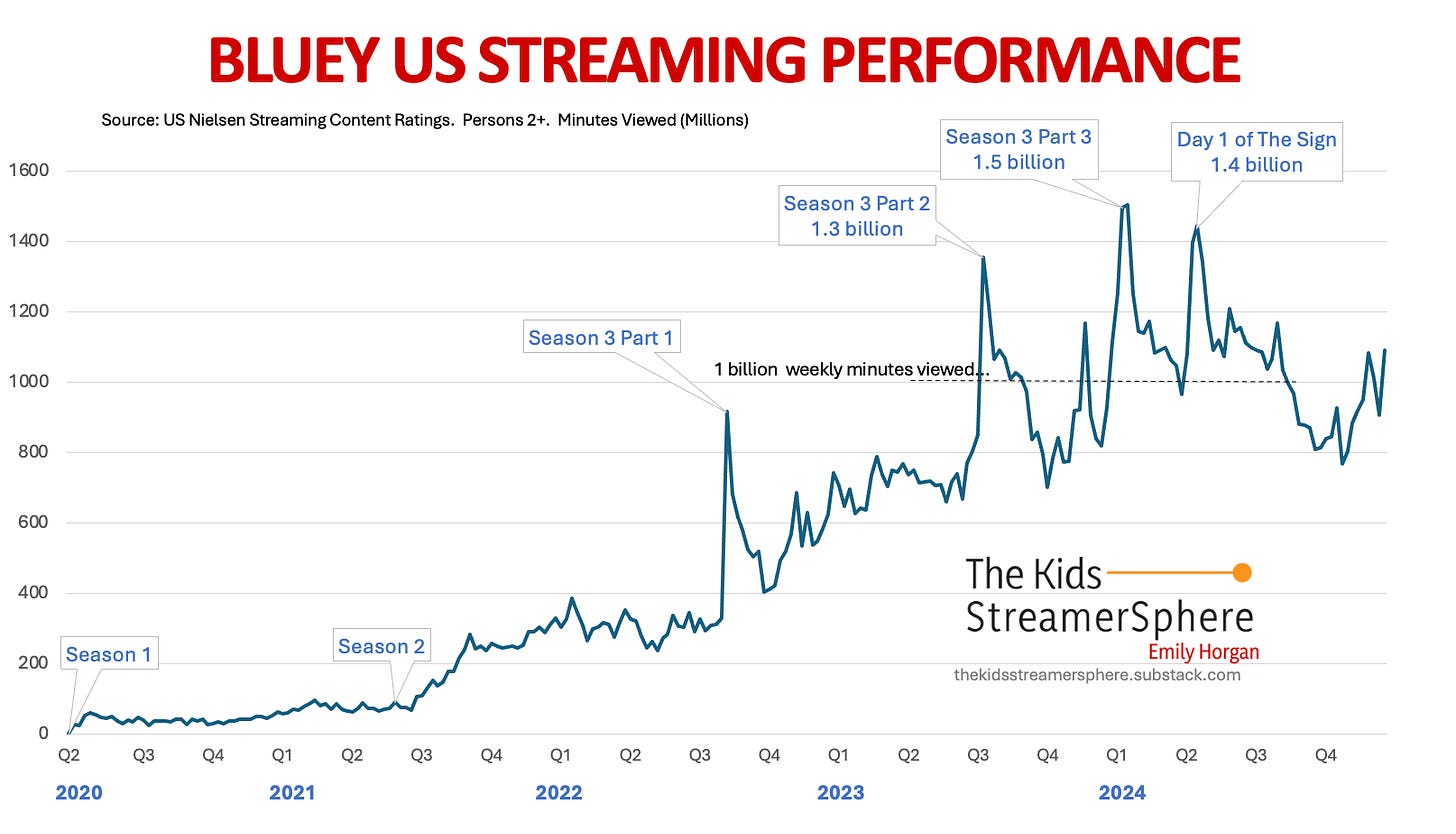A few weeks ago, we had Jasmine Dawson, SVP of Digital for BBC Studios, on the Kids Media Club Podcast. We were talking Bluey. Jasmine was awesome, deep, generous with insights, and brought a ton of background on how the franchise built digital fandom right from the start. I’m not surprised that our friends
and at The Media Odyssey lined her up for Cannes and am super excited to hear more from that chat. Any chance of an exclusive first listen, guys?The history of Bluey is long. I’ve written a thesis amount of wordcount at this stage on how the show has grown from its origins. There’s a great accompanying chart to all the background, in fact. One of my favorites (because that’s the kind of person I am, I have favorite charts). But I also think it’s the most important data chart in kids streaming right now—and here’s why.
Bluey Wasn’t Built in a Day. Bluey wasn’t built in 28 days. Bluey was built through a multi-year, multi-platform strategy that flowed between linear and streaming and YouTube and social and more.
Someone once asked me whether I thought Bluey would be in the same position today if Netflix had picked it up. I don’t think it would be. In 2021 the bubble was bursting on the streaming boom. In early 2022 came Netflix’s wobbly moment. Noses were blooded for series cancellations and boy, did they come for Netflix kids series. It’s hard to imagine Bluey would have survived the cull given its modest build.
On the other hand, with Disney distribution it had the best of all worlds. The routine-driven underpinning of linear channels. The priority investment in Disney+ roll out and scaling. Bluey was able to ride this like a wave precisely because it was a third-party utility show, free from Disney franchise dictates, valued only for its service to the platform. Disney have a history of making a good fist with shows like this. PJ Masks and Miraculous: Tales of Ladybug & Cat Noir came up the same way.
The thing you can’t see in this chart, or at least it’s only visible by its absence (see my ghetto doodling below), is all the hard work that was taking place in that 2020 – 2022 period. Jasmine spoke about this in her session with us: digital levers of fandom that were being built to really set the franchise alight. It’s obsessing about the data, it’s engaging with producers who get it and want it to work, it’s nurturing faith and trust with stakeholders that the investment is going to pay off. As she put it, it’s a creator mindset. Despite Bluey being a traditional IP, a key contributor to its success was a creator mindset on digital. Enabled by Disney being a great brand-building partner and not a needless digital gatekeeper.
And it paid off. Bluey Season 3 hit and the rest is history. The investments made in those first three years started to pay dividends. We can see Bluey streaming performance surge, but alongside this would have been a flurry of new Disney+ subscribers coming over from the free-to-access YouTube space. Kids content rarely gets its due for subscriber acquisition. It may not bring in the same volume as sports or marquee drama, but families stick around much longer, particularly when their favorite show is dropping new episodes.
So this is what we’re selling to stakeholders, and it’s a hard sell. A two-year ramp before you even know whether you’re successful is tough to swallow. Investment in the digital/YouTube space alongside that. But if you’re willing to make that commitment, you could have Bluey-sized success.
That’s why this chart matters so much: it’s proof that the kids streaming game isn’t won by the biggest marketing budget or the flashiest launch. It’s won by patience, faith, and relentless execution across every touchpoint where kids and families discover content. The chart shows the investment period, yes—but it also shows the exponential payoff when you get it right.
The tendency with big media is to look at kids IP and see the cost to be cut. In contrast, this chart shows the reward. And in an industry where everyone’s looking for the next big thing, sometimes the next big thing is simply willing to play the long game better than anyone else.





